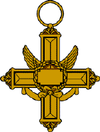| Distinguished Service Cross | |
|---|---|
 | |
| Type | Service cross medal |
| Awarded for | Extraordinary heroism in combat |
| Presented by | United States Department of the Army[1] |
| Eligibility | United States Army soldiers |
| Status | Currently awarded |
| First awarded | 18 March 1918[2] |
| Total | 13,462[3] |
  Service Ribbon (above) Obverse of the original cross & Reverse of current cross (below) | |
| Precedence | |
| Next (higher) | Medal of Honor |
| Equivalent |
|
| Next (lower) |
|
The Distinguished Service Cross (DSC) is the United States Army's second highest military decoration for soldiers who display extraordinary heroism in combat with an armed enemy force. Actions that merit the Distinguished Service Cross must be of such a high degree that they are above those required for all other U.S. combat decorations, but which do not meet the criteria for the Medal of Honor. The Army Distinguished Service Cross is equivalent to the Naval Services' Navy Cross, the Air and Space Forces' Air Force Cross, and the Coast Guard Cross. Prior to the creation of the Air Force Cross in 1960, airmen were awarded the Distinguished Service Cross.
The Distinguished Service Cross was first awarded during World War I. In addition, a number of awards were bestowed for actions which took place before World War I. In many cases, the medal was awarded to soldiers who had received a Certificate of Merit for gallantry; at the time, this certificate was the only other honor for gallantry the Army could present to combatants in lieu of a Medal of Honor. Others were furnished in belated recognition of actions which occurred in the Philippine–American War, during the Boxer Rebellion, and Pancho Villa Expedition.
The Distinguished Service Cross is distinct from the Distinguished Service Medal, which is awarded to Army soldiers in recognition of exceptionally meritorious service to the government of the United States in a duty of great responsibility. The Distinguished Service Cross is only awarded for actions in combat, while the Distinguished Service Medal has no such restriction.
- ^ "Army Regulation 600–8–22 Military Awards" (PDF). Rapid Action Revision (RAR). Washington, D.C.: Headquarters, Department of the Army. 11 December 2006. Archived from the original (PDF) on 11 January 2018. Retrieved 15 July 2022.
- ^ https://www.rollofhonor.org/public/htmldetails.aspx?Cat=award&EntID=3831
- ^ Lilley, Kevin (8 July 2018). "Centennial of honor: Silver Star, Distinguished Service Cross mark a milestone". Military Times. Retrieved 2 March 2019.
- ^ Cooper, Mechele (23 May 2010). "Mainer joins elite crew of Medal for Valor recipient". Kennebec Journal. Augusta, ME. Archived from the original on 2010-05-26. Retrieved 2011-07-18.